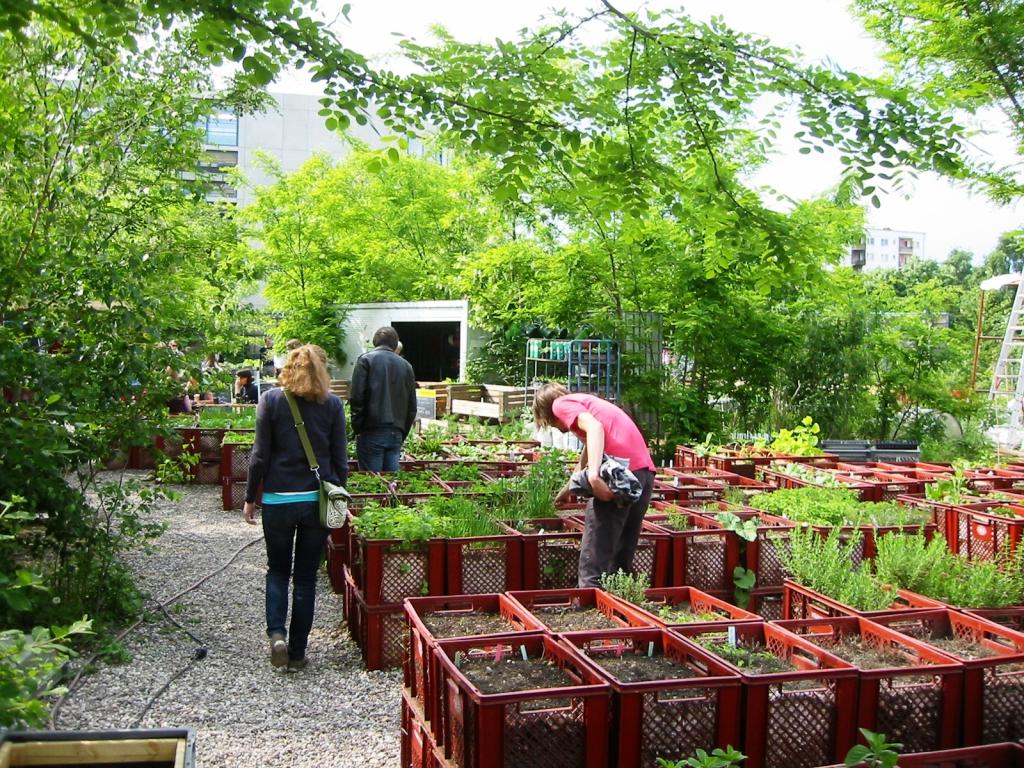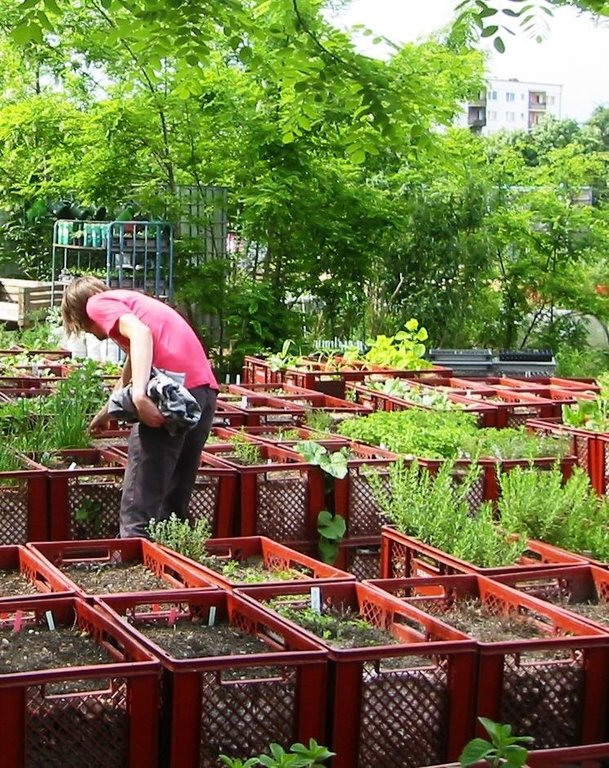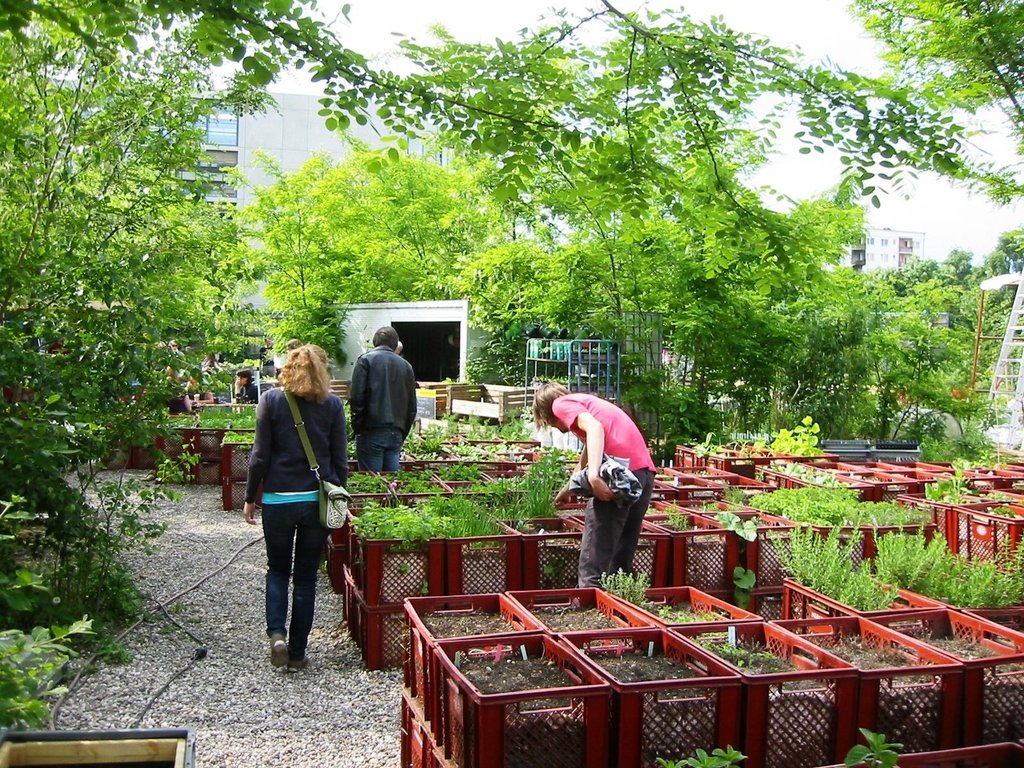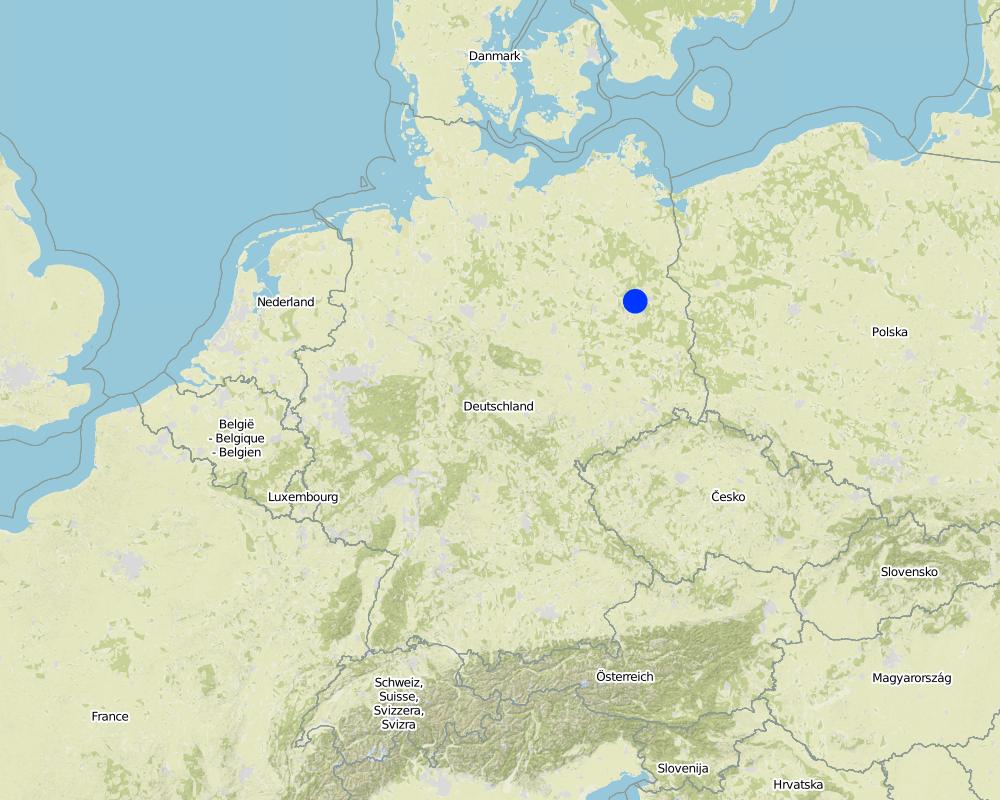Mobile Community Garden [Allemagne]
- Création :
- Mise à jour :
- Compilateur : Peter Kirch
- Rédacteur : –
- Examinateur : Fabian Ottiger
approaches_2603 - Allemagne
Voir les sections
Développer tout Réduire tout1. Informations générales
1.2 Coordonnées des personnes-ressources et des institutions impliquées dans l'évaluation et la documentation de l'Approche
Spécialiste GDT:
Shaw Robert
kontakt@prinzessinnengarten.net
PRINZESSINNENGARTEN BERLIN
Prinzenstrasse 35 – 38, Berlin
Allemagne
Nom du ou des institutions qui ont facilité la documentation/ l'évaluation de l'Approche (si pertinent)
Technische Universität Berlin (Technische Universität Berlin) - Allemagne1.3 Conditions relatives à l'utilisation par WOCAT des données documentées
Quand les données ont-elles été compilées (sur le terrain)?
08/05/2015
Le compilateur et la(les) personne(s) ressource(s) acceptent les conditions relatives à l'utilisation par WOCAT des données documentées:
Oui
2. Description de l'Approche de GDT
2.1 Courte description de l'Approche
The SLM approach can be defined as community supported mobile urban farm, which serves the goals of vegetable production, and place of learning and knowledge sharing.
2.2 Description détaillée de l'Approche
Description détaillée de l'Approche:
Aims / objectives: The objective of the SLM approach 'Prinzessinnengarten' was to create an urban garden on a waste land plot in the center of Berlin. The plot was characterised by having sealed and contaminated soils, which is characteristic for open land plots in most urban areas. The garden is supposed to practically demonstrate an ecologically and socially different approach to urban spaces and their inhabitants, enable the social empowerment of marginalized communities. Furthermore opportunities for local micro-economies and other economic models are supposed to be created. In an unobtrusive and pragmatic way, urban gardens in general aim to raise the question of 'How we want to live in our cities in the future?
Methods: The project was first was implemented by the group Nomadisch Grün (Nomadic Green) in summer of 2009. Along with friends, activists and neighbours, the group realised the first steps of implementation through clearing of rubbish and through the construction of the first cultivation units. The project, being open to everybody, attracted new participants quite fast. Now the garden owes its existence to the commitment of countless neighbors and interested people. The work of these participants, their diverse skills and ideas transform the place continuously.
Stages of implementation: I. Development of the idea. During this phase of implementation mainly Robert Shaw (he was involved in similar projects in Cuba before) and Marco Clausen were involved.. II. Implementation in practice. Starting in summer of 2009, the project idea was being implemented on the ground by a group of people. During this stage of implementation mainly physical work, such as the clearing of rubbish was realised. III. Opening to the wider public (still ongoing). The non-profit company 'Nomadisch Grün (Nomadic Green) serves as a framework for the different social, educational and economic activities with the primary aim of making the garden a place of learning. Skills are gained through practical experience and knowledge sharing.
2.3 Photos de l'approche
2.5 Pays/ région/ lieux où l'Approche a été appliquée
Pays:
Allemagne
Région/ Etat/ Province:
Berlin
Autres spécifications du lieu :
Kreuzberg
Map
×2.6 Dates de début et de fin de l'Approche
Indiquez l'année de démarrage:
2009
2.7 Type d'Approche
- initiative/ innovation récente locale
2.8 Principaux objectifs de l'Approche
The Approach focused mainly on other activities than SLM (utilisation of waste land/abandoned land plots, urban areas,production of vegetables, place of knowledge sharing)
The aim of the project was to find solutions for the lack of knowledge sharing within the society and to address the topic of food production.
The SLM Approach addressed the following problems: The main problems addressed by the approach can be described as manifold, e.g. insufficient local food production, or the general lack of public spaces for knowledge sharing and exchange within the community.
2.9 Conditions favorisant ou entravant la mise en œuvre de la(des) Technologie(s) appliquée(s) sous l'Approche
disponibilité/ accès aux ressources et services financiers
- entrave
Treatment through the SLM Approach: attempt to diversify the income
cadre institutionnel
- entrave
no official institution is clearly responsible for this type of approach
Treatment through the SLM Approach: regular exchange with politicians, especially on local level
cadre juridique (régime foncier, droits d'utilisation des terres et de l'eau)
- favorise
The existing land ownership, land use rights / water rights helped a little the approach implementation: As the existing land ownership was already known before the implementation of the approach started, this aspect was being strongly considered (leading to the design of a mobile cultivation system). Furthermore the existing land ownership (the community is owning the land) led to the possibility to have public negotiations about the renting contract. If the area would have been in private ownership such negotiations would not have been possible and it is more than likely that the Approach could not have been realised in the way it is realised now.
- entrave
no long term renting contract, no official institution is clearly responsible for this type of approach
Treatment through the SLM Approach: political campaign
charge de travail, disponibilité de la main-d'œuvre
- entrave
due to the high presence in the media there is a high demand for communication acitivities
Treatment through the SLM Approach: establishment of paid jobs to have people working professionally on certain topics
3. Participation et rôles des parties prenantes impliquées dans l'Approche
3.1 Parties prenantes impliquées dans l'Approche et rôles
- exploitants locaux des terres / communautés locales
In the surroundings of the Moritzplatz a great part of the population were/are immigrants (most of them coming from muslim countries) and people without a job. In principle the project was/is open for all people, including disadvantaged groups as well. During the interviews it was said though that the selling and consumption of alcohol on the project area could have led to the fact that especially immigrants from muslim countries could have been felt excluded.
3.2 Participation des exploitants locaux des terres/ communautés locales aux différentes phases de l'Approche
| Participation des exploitants locaux des terres/ communautés locales | Spécifiez qui était impliqué et décrivez les activités | |
|---|---|---|
| initiation/ motivation | auto-mobilisation | There was a constant change of the people that were being involved in the different phases of the project. The decision to what degree people got involved, were to be taken under the consideration of the personal needs and possibilities. |
| planification | auto-mobilisation | There was a constant change of the people that were being involved in the different phases of the project. The decision to what degree people got involved, were to be taken under the consideration of the personal needs and possibilities. |
| mise en œuvre | auto-mobilisation | There was a constant change of the people that were being involved in the different phases of the project. The decision to what degree people got involved, were to be taken under the consideration of the personal needs and possibilities. |
| suivi/ évaluation | auto-mobilisation | There was a constant change of the people that were being involved in the different phases of the project. The decision to what degree people got involved, were to be taken under the consideration of the personal needs and possibilities. |
| Research | interactive |
3.4 Prises de décision pour la sélection de la Technologie/ des Technologies
Indiquez qui a décidé de la sélection de la Technologie/ des Technologies à mettre en œuvre:
- les exploitants des terres seuls (auto-initiative)
Expliquez:
Decisions on the method of implementing the SLM Technology were made by by land users* alone (self-initiative / bottom-up)
4. Soutien technique, renforcement des capacités et gestion des connaissances
4.1 Renforcement des capacités/ formation
Une formation a-t-elle été dispensée aux exploitants des terres/ autres parties prenantes?
Oui
Spécifiez qui a été formé:
- exploitants des terres
Formats de la formation:
- sur le tas
- entre agriculteurs (d'exploitants à exploitants)
- zones de démonstration
- réunions publiques
- cours
Thèmes abordés:
Through creating a open public space/place and by offering manifold practical activity the approach provides training by using a peer to peer approach on topics like biodiversity, healthy eating, recycling, environmental justice, climate change and food sovereignty. This training / awareness raising takes place informally (peer to peer) as well as formally (announced courses, lectures, discussions)
4.2 Service de conseils
Les exploitants des terres ont-ils accès à un service de conseils?
Oui
Décrivez/ commentez:
Advisory service is inadequate to ensure the continuation of land conservation activities
4.3 Renforcement des institutions (développement organisationnel)
Des institutions ont elles été mises en place ou renforcées par le biais de l'Approche?
- non
4.4 Suivi et évaluation
Le suivi et l'évaluation font ils partie de l'Approche? :
Oui
Commentaires:
bio-physical aspects were ad hoc monitored by land users through observations
bio-physical aspects were regular monitored by other through measurements
technical aspects were ad hoc monitored by land users through observations
socio-cultural aspects were ad hoc monitored by land users through observations
economic / production aspects were ad hoc monitored by land users through observations
no. of land users involved aspects were ad hoc monitored by land users through observations
management of Approach aspects were ad hoc monitored by land users through observations
There were several changes in the Approach as a result of monitoring and evaluation: There is a constant change according to the findings of the monitoring and the needs/possibilites of the project participants.
There were few changes in the Technology as a result of monitoring and evaluation: The research of the Technical University of Berlin showed that vegetables which were cultivated very close to the street, contained more pollutants. Therefore a 'green belt' of about 2 m width was established around the garden, where only non-food-crops are cultivated
4.5 Recherche
La recherche a-t-elle fait partie intégrante de l’Approche?
Oui
Spécifiez les thèmes:
- écologie
Donnez plus de détails et indiquez qui a mené ces recherches:
There was research on the soil and plant quality and possible contamination of the soil and the plants (performed e.g. by the Technical University of Berlin)
Research was carried out both on station and on-farm
5. Financement et soutien matériel externe
5.1 Budget annuel de la composante GDT de l'Approche
Si le budget annuel précis n'est pas connu, indiquez une fourchette:
- 100 000-1 000 000
Commentez (par ex. principales sources de financement/ principaux bailleurs de fonds):
Approach costs were met by the following donors: local community / land user(s): 100.0%
5.2 Soutiens financiers/ matériels fournis aux exploitants des terres
Les exploitants des terres ont-ils reçu un soutien financier/ matériel pour la mise en œuvre de la Technologie/ des Technologies?
Oui
5.3 Subventions pour des intrants spécifiques (incluant la main d'œuvre)
- infrastructures
| Spécifiez les intrants subventionnés | Dans quelle mesure | Spécifiez les subventions |
|---|---|---|
| Kitchen | en partie financé | For educational purposes |
Si la main d'œuvre fournie par les exploitants des terres était un intrant substantiel, elle était:
- volontaire
5.4 Crédits
Des crédits ont-ils été alloués à travers l'Approche pour les activités de GDT?
Non
6. Analyses d'impact et conclusions
6.1 Impacts de l'Approche
Est-ce que l'Approche a aidé les exploitants des terres à mettre en œuvre et entretenir les Technologies de GDT?
- Non
- Oui, un peu
- Oui, modérément
- Oui, beaucoup
The approach helped the land users to cultivate on areas, which were not suitable for cultivation before. Furthermore the approach enhanced the knowledge sharing concering different topics regarding sustainable land management. Therefore the impact of the Approach on SLM is not only to be measured on the project area itself, but also under consideration of the outreach of the project.
Est-ce que l'Approche a autonomisé les groupes socialement et économiquement défavorisés?
- Non
- Oui, un peu
- Oui, modérément
- Oui, beaucoup
Through the Approach a space for knowledge sharing was created, which is also open for socially and economically disadvantaged groups. The utilisation of this space by the groups in question is limited up to date though.
Did other land users / projects adopt the Approach?
- Non
- Oui, un peu
- Oui, modérément
- Oui, beaucoup
The approach was adopted in modified ways in several urban gardening projects accross Germany. It is not possible to quantify the number. A guess would be around 20.
Did the Approach lead to improved livelihoods / human well-being?
- Non
- Oui, un peu
- Oui, modérément
- Oui, beaucoup
Creation of a space open to the public, which is dedicated for knowledge sharing.
Did the Approach help to alleviate poverty?
- Non
- Oui, un peu
- Oui, modérément
- Oui, beaucoup
The goal of the approach was not set on the alleviation of poverty.
6.2 Principale motivation des exploitants des terres pour mettre en œuvre la GDT
- augmenter la production
- affiliation à un mouvement/ projet/ groupe/ réseaux
- conscience environnementale
- well-being and livelihoods improvement
6.3 Durabilité des activités de l'Approche
Les exploitants des terres peuvent-ils poursuivre ce qui a été mis en œuvre par le biais de l'Approche (sans soutien extérieur)?
- oui
Si oui, décrivez de quelle manière:
Through the diverse income opportunities (consulting, selling/using the produce in gastronomy, donation) the Approach activities can be self-financed.
6.4 Points forts/ avantages de l'Approche
| Points forts/ avantages/ possibilités du point de vue de l'exploitant des terres |
|---|
| not dependent on a certain plot (mobility, flexibility) |
| flat hierachy leads to the fact, that a lot of people can bring in their ideas easily |
| Everybody can decide on his/her own to what extend he/she wants to get involved and in what kind of activity. Through this the participants can focus on their strengths and there is little chance that overworking occurs. |
| Creation of paid jobs |
| Points forts/ avantages/ possibilités du point de vue du compilateur ou d'une autre personne ressource clé |
|---|
| self-financed |
| sharing of knowledge (possible between all participants) |
| open to everybody |
6.5 Faiblesses/ inconvénients de l'Approche et moyens de les surmonter
| Faiblesses/ inconvénients/ risques du point de vue de l’exploitant des terres | Comment peuvent-ils être surmontés? |
|---|---|
| only to a certain point 'sustainable', as the project is dependent on a great amount of external inputs (water, plastic boxes) |
| Faiblesses/ inconvénients/ risques du point de vue du compilateur ou d'une autre personne ressource clé | Comment peuvent-ils être surmontés? |
|---|---|
| only to a certain point 'sustainable', as the project is dependent on a great amount of external inputs (water, plastic boxes) |
7. Références et liens
7.1 Méthodes/ sources d'information
- visites de terrain, enquêtes sur le terrain
- interviews/entretiens avec les exploitants des terres
7.2 Références des publications disponibles
Titre, auteur, année, ISBN:
website, 2015
Disponible à partir d'où? Coût?
prinzessinnengarten.net/
Liens et modules
Développer tout Réduire toutLiens
Aucun lien
Modules
Aucun module trouvé







